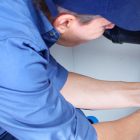When your refrigerator stops cooling properly, the thermostat is often the culprit. Replacing a faulty refrigerator thermostat isn’t as complicated as it sounds, and you don’t always need to call a professional. By following this step-by-step guide, you can fix it yourself, saving both time and money. Read on to learn everything you need to know about diagnosing, replacing, and maintaining your fridge’s thermostat.
For quick assistance, call us at +971545356777 for expert help.
Contents
- 1 What Is a Refrigerator Thermostat?
- 2 Tools and Materials Needed to Replace a Refrigerator Thermostat
- 3 Step-by-Step Instructions for Replacing a Refrigerator Thermostat
- 4 Common Issues and Troubleshooting When Replacing a Refrigerator Thermostat
- 5 Maintaining Your Refrigerator After Replacing the Thermostat
- 6 Conclusion: Stay Cool with a Functional Refrigerator Thermostat
What Is a Refrigerator Thermostat?
Before jumping into the replacement process, it’s important to understand what a refrigerator thermostat is and why it’s vital to your fridge’s function. A thermostat controls the refrigerator’s temperature by sensing the temperature inside the appliance and signaling the cooling system when it needs to start or stop running. This constant monitoring ensures that your food stays at the ideal temperature.
In many cases, a faulty thermostat can result in too much or too little cooling. For instance, if the thermostat is stuck in the “on” position, your refrigerator could become too cold, freezing everything inside. Conversely, a stuck “off” thermostat can lead to a warm fridge, spoiling your food.
When should you consider replacing the refrigerator thermostat? If your fridge is either too warm or too cold and adjusting the settings has no effect, the thermostat may be to blame. Other signs include inconsistent temperatures or unusual cycling patterns where the fridge runs too often or too rarely.
Tools and Materials Needed to Replace a Refrigerator Thermostat
Replacing a refrigerator thermostat requires some basic tools and materials that you likely already have around the house. Before you begin, make sure to gather everything to avoid unnecessary interruptions during the repair.
Here’s a checklist of what you’ll need:
- New refrigerator thermostat (Make sure it matches your fridge model.)
- Screwdrivers (Phillips and flathead)
- Pliers
- Multimeter (for testing electrical connections)
- Insulated gloves (for safety)
- Needle-nose pliers
- Flashlight (for better visibility inside the fridge)
You can purchase a replacement thermostat online or from your local appliance store. It’s essential to double-check that the part is compatible with your refrigerator model, as different fridges may use varying thermostat designs. If you’re unsure, call us at +971545356777 for expert advice and to ensure you get the right part.
Step-by-Step Instructions for Replacing a Refrigerator Thermostat
Now that you’ve gathered the necessary tools, let’s walk through the steps to replace your refrigerator thermostat.
1. Disconnect the Power Supply
Safety comes first. Before you start any repair work, unplug your refrigerator from the wall outlet. This step prevents accidental electrocution while you work. If you can’t reach the plug easily, you can also turn off the power from the circuit breaker that controls your kitchen.
2. Locate the Thermostat
The next step is finding the refrigerator thermostat. In most refrigerators, the thermostat is located either inside the fridge near the top or behind a panel. It’s typically connected to the control dial that adjusts the fridge temperature.
If you’re unsure where the thermostat is located, consult your refrigerator’s manual. You may need to remove some shelves or panels to access it properly. Use a screwdriver to carefully unscrew any coverings.
3. Remove the Thermostat
Once you’ve located the thermostat, it’s time to remove it. Start by disconnecting the wires attached to the old thermostat. You may need to use needle-nose pliers to gently pull the connectors loose. Take note of how the wires are arranged, as you’ll need to connect them the same way to the new thermostat.
Next, unscrew the mounting screws that hold the refrigerator thermostat in place. Once it’s free, carefully pull the old thermostat out of its housing.
4. Test the Old Thermostat (Optional)
If you want to double-check that the thermostat is indeed faulty, you can use a multimeter to test it. Set the multimeter to the continuity setting and touch the probes to the thermostat’s terminals. If you get a reading of zero or infinity, the thermostat is faulty and needs to be replaced.
If you’re not comfortable with this step, don’t worry—just proceed to the next one or call a professional at +971545356777 for assistance.
5. Install the New Thermostat
Installing the new refrigerator thermostat is essentially the reverse of removing the old one. Start by connecting the wires to the correct terminals on the new thermostat. Make sure the connections are tight and secure.
Next, position the new thermostat into its housing and screw it into place. Be careful not to overtighten the screws, as this can damage the thermostat.
6. Reassemble the Refrigerator
After installing the new thermostat, replace any panels or shelves that you removed earlier. Double-check that everything is properly secured before moving on to the next step.
7. Restore Power and Test
Finally, plug the refrigerator back into the power outlet or turn the circuit breaker back on. Set the fridge to the desired temperature and wait a few hours to see if it cools correctly. You should notice the fridge cycling on and off as it maintains the right temperature.
If the problem persists, it may indicate a more complex issue that requires professional help. Feel free to call us at +971545356777 for troubleshooting and further assistance.
Common Issues and Troubleshooting When Replacing a Refrigerator Thermostat
Even though replacing a refrigerator thermostat is usually straightforward, some common issues can arise during or after the installation. Here’s how to address them:
1. Fridge Still Not Cooling Properly
If your fridge still isn’t cooling properly after replacing the thermostat, there could be several other potential causes. The issue might be related to the compressor, evaporator fan, or coolant levels. In such cases, professional intervention is required, as these parts are more complex to replace.
2. Thermostat Not Cycling
Sometimes, the new refrigerator thermostat may not cycle the fridge correctly. This could happen if the thermostat wires were connected incorrectly, or the thermostat isn’t compatible with your model. Always ensure that you’ve purchased the right thermostat for your refrigerator model.
3. Thermostat Doesn’t Fit
If the new thermostat doesn’t fit in the housing or won’t mount correctly, it’s likely because it’s not designed for your fridge model. Double-check the part number before purchasing a new thermostat to avoid this issue. For help finding the right replacement part, call us at +971545356777.
Maintaining Your Refrigerator After Replacing the Thermostat
Once your new refrigerator thermostat is installed and functioning correctly, you’ll want to take steps to ensure your refrigerator stays in top shape. Regular maintenance not only extends the life of your fridge but also prevents future problems.
1. Clean the Coils Regularly
Refrigerator coils, located either on the back or underneath the unit, are responsible for cooling the refrigerant. Over time, they collect dust and debris, which can reduce their efficiency. Cleaning the coils every six months will help keep your fridge running smoothly.
2. Check the Seals
The door seals, or gaskets, are another important part of your fridge’s cooling system. A loose or damaged seal allows warm air to enter the fridge, making the cooling system work harder. Check the seals regularly and replace them if needed.
3. Monitor the Temperature
Keep an eye on the internal temperature of your fridge, especially in the days following a thermostat replacement. It should stay between 37°F and 40°F (3°C to 4°C). If it fluctuates, the refrigerator thermostat may need adjustment.
Conclusion: Stay Cool with a Functional Refrigerator Thermostat
Replacing a refrigerator thermostat is a cost-effective solution to a cooling issue that anyone with basic DIY skills can handle. By following this guide, you’ll have your refrigerator back in working order in no time. However, if you encounter any issues or feel uncertain at any stage of the process, don’t hesitate to reach out for professional help.
For any questions or expert assistance, contact us at +971545356777. We’re always here to help keep your fridge cool and your food fresh!



